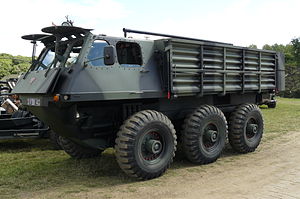Alvis Stalwart
| Alvis Stalwart | |
|---|---|
 |
|
| Place of origin |
|
| Specifications | |
| Weight | 9 tonnes |
| Length | 6.36 m |
| Width | 2.62 m |
| Height | 2.31 m |
| Crew | driver + 2 passengers |
|
|
|
| Armor | none |
|
Main
armament |
none |
|
Secondary
armament |
none |
| Engine | Rolls Royce B81 MK 8B eight-cylinder water-cooled 6.5 l petrol, |
| Suspension | 6 x 6 wheels |
|
Operational
range |
640 km |
The FV 620 Stalwart, informally known by servicemen as the 'Stolly', is a highly mobile amphibious military truck built by Alvis that served with the British Army from 1966 until the 1980s.
The Stalwart was a private venture by Alvis that was adopted and entered service with the British Army in 1966 as a general transport truck in preference to the FV431, the load carrier variant of the FV430 series. It was one of the same line of vehicles that included the Alvis Saracen, Saladin and Salamander. The high mobility and amphibious capabilities were considered ideal for resupplying units in the field, particularly those of the BAOR.
The hull is the vehicle chassis, the engine is situated under the load deck in the rear of the hull and the gearboxes, differentials and transfer boxes forward of this. The load deck was open-topped with large drop down panels on either side. Waterproof seals ensured that these would not leak when in the water. The three man cab has the driver's position in the centre and a seat for a passenger either side. The cab can only be entered through roof hatches.
The Stalwart could carry 5 tonnes of stores, or tow 10 tonnes.
In the water it could be driven at about 6 knots by vectored thrust water-jet propulsion units.
The drive system, which included the all-wheel drive, multiple gearboxes, and the water propulsion units, was complex and needed a lot of maintenance. When the amphibious qualities become unnecessary, it was common for the water jets to be removed to reduce weight and maintenance.
The Stalwart's impressive over-terrain capabilities came from the fact that the 6-wheel-drive system lacked differentials, using simple bevel gears to transmit drive. A centre mounted no-spin differential allowed a certain amount of slip between the two sets of wheels on each side of the vehicle on hard surfaces, but there was no allowance for rotational speed differences between front and rear. The centre no-spin unit allowed the wheels on either side of the vehicle with most grip to drive when off-road. This had the effect of making the vehicle appear to crab (move from side to side) when negotiating muddy conditions, thus making the Stalwart a true 6-wheel-drive vehicle, with 3 wheels locked together and turning at the same speed.
...
Wikipedia
